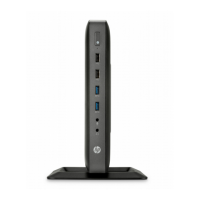
Do you have a question about the HP t620 and is the answer not in the manual?
| L2 cache | 1 MB |
|---|---|
| Processor cores | 2 |
| Processor model | GX-217GA |
| Processor family | AMD G |
| Motherboard chipset | - |
| Processor frequency | 1.65 GHz |
| Storage media | SSD |
| Card reader integrated | No |
| Total storage capacity | 32 GB |
| Internal memory | 4 GB |
| Memory clock speed | 1600 MHz |
| Internal memory type | DDR3L-SDRAM |
| On-board graphics card model | AMD Radeon HD 8280E |
| Ethernet LAN | Yes |
| Cabling technology | 10/100/1000Base-T(X) |
| USB 2.0 ports quantity | 6 |
| Ethernet LAN (RJ-45) ports | 1 |
| VGA (D-Sub) ports quantity | 0 |
| Operating system installed | Windows Embedded 8 Standard |
| Operating system architecture | 64-bit |
| Product color | Black |
| Power supply | 65 W |
| AC input voltage | 100-240 V |
| AC input frequency | 50 - 60 Hz |
| Country of origin | China |
| Depth | 40 mm |
|---|---|
| Width | 220 mm |
| Height | 240 mm |
| Weight | 1360 g |
Details the front panel ports and buttons of the HP thin client.
Details the rear panel ports and connectors of the HP thin client.
Location of the unique serial number for customer assistance.
Important safety instructions, warnings, and cautions before performing hardware upgrades.
Step-by-step instructions for connecting the power cord to the HP thin client.
Instructions for attaching the computer stand in both tower and horizontal orientations.
Procedure for safely removing the computer's access panel.
Procedure for safely replacing the computer's access panel.
Step-by-step guide for installing USB flash drives internally into the system board.
Information and procedures for installing memory modules (SODIMMs) into the thin client.
Information about the type and capacity of memory modules (SODIMMs) supported by the system.
Specifications required for DDR3L-SDRAM SODIMM modules for proper system operation.
Details on the location and identification of SODIMM sockets on the system board.
Step-by-step instructions for installing SODIMM memory modules into the computer.
Instructions for installing an optional half-height PCI-Express card into the thin client.
Guide for installing a half-height PCI-Express 2.0 card into the HP thin client.
Overview of security features including hood sensor and cable lock.
Explanation of the hood sensor's function for detecting access panel removal.
Instructions on how to use a security cable lock to secure the thin client.
Detailed steps for removing and replacing the system battery.
Overview of functions available in the Computer Setup (F10) utility for system configuration.
Step-by-step guide on how to access and navigate the Computer Setup (F10) utility.
Details on system information and basic settings within the Computer Setup utility.
Configuration options for storage devices, SATA emulation, and boot order in BIOS.
Security settings including setup password, power-on password, and device security options.
Power management settings within the Computer Setup utility, including hardware power management.
Advanced configuration options for Power-On, BIOS, and onboard devices in the BIOS.
Methods for changing BIOS settings directly from the operating system using HPBCU.
Explanation of Power and IDE Flash Activity LEDs and their status meanings.
How to enable or disable Wake-on LAN (WOL) functionality via BIOS settings.
Description of the hardware initialization and diagnostic steps performed during power-on.
Procedures for resetting BIOS setup and power-on passwords.
Details of the basic hardware integrity tests performed during the power-on sequence.
Guide to understanding front panel LED codes and audible alerts during POST.
Interpretation of numeric codes and text messages encountered during POST.
General troubleshooting steps for operating problems and power-on issues.
Specific troubleshooting steps for diskless units regarding network boot and IP configuration.
Information and references for configuring a PXE server for network booting.
Prerequisites and requirements for reflashing or restoring the system software image.
Initial steps and deployment options for restoring the system image.
Instructions for formatting a USB flash drive for image restoration.
Steps for unpacking image files and deployment tools for system restore.
Instructions for deploying the system image using PXE.
Procedures for updating or restoring the system BIOS using HP Device Manager or other methods.
General requirements for power cord sets, including approvals and specifications.
Specific requirements for using power cords in Japan.
Country-specific requirements and accredited agencies for power cord sets.
Physical dimensions of the HP 1620 Thin Client models.
Operating and non-operating temperature ranges for the thin client.